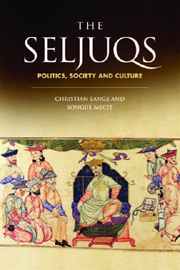Book contents
- Frontmatter
- Contents
- List of figures
- Acknowledgements
- List of abbreviations
- INTRODUCTION
- PART I POLITICS
- PART II SOCIETY
- 6 ARSLĀN ARGHŪN – NOMADIC REVIVAL?
- 7 CONTROLLING AND DEVELOPING BAGHDAD: CALIPHS, SULTANS AND THE BALANCE OF POWER IN THE ABBASID CAPITAL (MID-5TH/11TH TO LATE 6TH/12TH CENTURIES)
- 8 THE SELJUQS AND THE PUBLIC SPHERE IN THE PERIOD OF SUNNI REVIVALISM: THE VIEW FROM BAGHDAD
- 9 CHANGES IN THE OFFICE OF ḤISBA UNDER THE SELJUQS
- 10 AN EMBLEMATIC FAMILY OF SELJUQ IRAN: THE KHUJANDĪS OF ISFAHAN
- Part III CULTURE
- Index
8 - THE SELJUQS AND THE PUBLIC SPHERE IN THE PERIOD OF SUNNI REVIVALISM: THE VIEW FROM BAGHDAD
from PART II - SOCIETY
Published online by Cambridge University Press: 12 September 2012
- Frontmatter
- Contents
- List of figures
- Acknowledgements
- List of abbreviations
- INTRODUCTION
- PART I POLITICS
- PART II SOCIETY
- 6 ARSLĀN ARGHŪN – NOMADIC REVIVAL?
- 7 CONTROLLING AND DEVELOPING BAGHDAD: CALIPHS, SULTANS AND THE BALANCE OF POWER IN THE ABBASID CAPITAL (MID-5TH/11TH TO LATE 6TH/12TH CENTURIES)
- 8 THE SELJUQS AND THE PUBLIC SPHERE IN THE PERIOD OF SUNNI REVIVALISM: THE VIEW FROM BAGHDAD
- 9 CHANGES IN THE OFFICE OF ḤISBA UNDER THE SELJUQS
- 10 AN EMBLEMATIC FAMILY OF SELJUQ IRAN: THE KHUJANDĪS OF ISFAHAN
- Part III CULTURE
- Index
Summary
During the late 5th/11th and 6th/12th centuries – a period often called the Sunni revival – a mainstream Sunni camp was emerging in the Islamic Near East. In their effort to end the religious ferment of the late classical period, Muslim scholars (the ʿulamāʾ) and others combined to delimit a commonly accepted form of Islam, eliminate various sources of contention within the Islamic community, and set up the tone in the public sphere based on the Sunna and the Sharīʿa. The process of homogenisation of religious doctrine and practice had institutional and social dimensions as well. Associations and frameworks were developed to teach the Islamic religious and legal sciences, apply religious law, and harness mainstream Sufism. The four Sunni madhhabs consolidated as scholarly establishments, as pools for appointments to positions in the legal apparatus, as well as nuclei of public sphere arenas. The madrasas made their appearance as formally and lavishly endowed institutions of legal learning, and centres for devotion and learning (khānqāhs, ribāṭs or zāwiyas) were founded for what may be labelled the mainstream Sufitradition that brought together mystical and legal learning. Consequently, the space dominated by legal scholars and the ‘righteous’ Sufis was enlarged. These developments took place against the background of the Abbasid caliphate's disintegration and the subsequent rise to power of the sultanate of the Great Seljuqs.
As a major scene in the crystallisation of the madhhabs and the development of the madrasa in its ‘mature’ form, Seljuq Baghdad figured prominently in the Sunnisation process.
- Type
- Chapter
- Information
- The SeljuqsPolitics, Society and Culture, pp. 139 - 156Publisher: Edinburgh University PressPrint publication year: 2011



